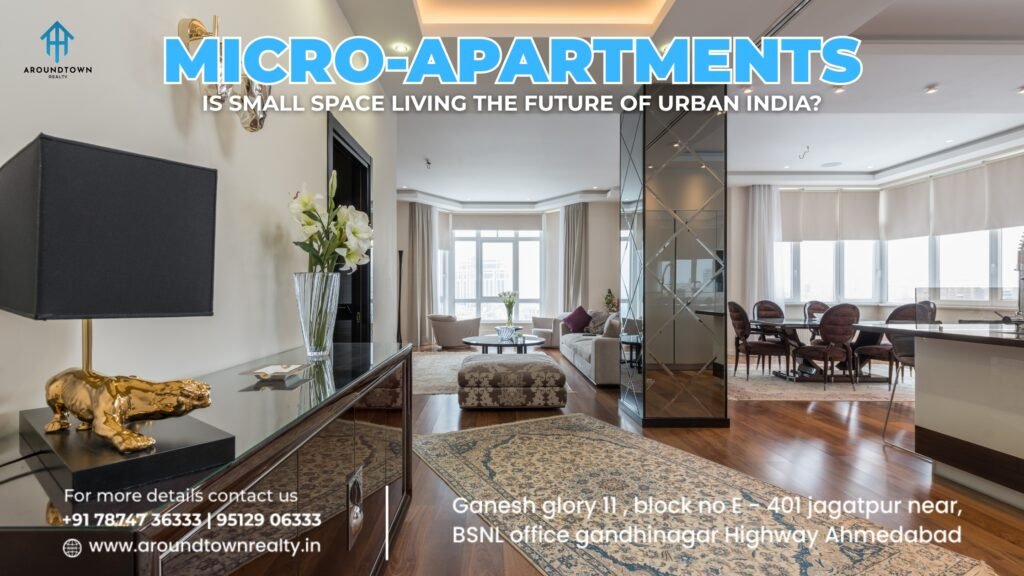In a country like India where urban population growth is exploding, the concept of housing has undergone a dramatic shift. One of the most prominent outcomes of this urban transformation is the emergence of micro-apartments. As space becomes a premium and affordability becomes a barrier for homeownership in metro cities, more and more buyers and investors are asking the question: Is small space living the inevitable future of urban India?
This blog explores the rise of micro-apartments in Indian cities, the economic, social, and design forces driving their popularity, and how they are redefining the concept of home in modern India.
Understanding Micro-Apartments: More Than Just Small Homes
Micro-apartments are compact residential units, typically between 150 to 400 square feet, designed to optimize every inch of space through intelligent architecture and design solutions. These homes are not makeshift or cramped alternatives but rather deliberate, well-planned living spaces aimed at providing functionality, affordability, and urban connectivity in a limited area.
Unlike traditional small apartments that may lack amenities or quality construction, micro-apartments are often built in prime locations with modern facilities, efficient layouts, and multi-functional furniture that supports a contemporary urban lifestyle.
Why Micro-Apartments Are Becoming Popular in Indian Cities
1. Escalating Real Estate Prices in Metros
The cost of property in cities like Mumbai, Delhi, Bengaluru, and Pune has skyrocketed over the last decade. For many working professionals, students, and first-time homebuyers, buying a traditional 2BHK or even a spacious 1BHK has become financially unfeasible. Micro-apartments bridge this affordability gap by offering ownership opportunities at a much lower price point, without compromising on connectivity or lifestyle convenience.
2. Demographic Shifts: Rise of the Urban Individual
India is witnessing a clear shift in household demographics. With more young professionals living independently, more people delaying marriage, and more nuclear family structures emerging, the demand for solo living options has gone up. Micro-apartments cater perfectly to these needs—offering a private, secure, and low-maintenance environment.
3. Changing Lifestyle Priorities
Today’s urban population, particularly millennials and Gen Z, values location, convenience, and access over square footage. These generations are more likely to invest in experiences, mobility, and technology, rather than spacious, traditional homes. Micro-living supports these priorities by placing residents closer to workplaces, entertainment hubs, and transit networks.
4. Rising Rental Demand and Investment Potential
For investors, micro-apartments offer an excellent rental proposition. Because of their affordability and demand among students, bachelors, and working professionals, these homes can fetch high rental yields per square foot. In cities with high migration, they also experience low vacancy rates, making them attractive as long-term rental assets.
5. Emphasis on Sustainable Living
Micro-apartments naturally promote sustainability. They consume fewer building materials, use less water and electricity, and encourage minimalist consumption. This aligns with the growing awareness among urban Indians around eco-friendly living and sustainable resource use.
How Micro-Apartments Maximize Space: Innovative Design Strategies
Developers and architects are innovating rapidly to ensure that limited space does not mean compromised comfort. Some common features include:
- Multi-functional furniture: Beds that fold into walls, dining tables that double up as workstations, and storage-integrated seating.
- Open-plan layouts: To eliminate visual clutter and enhance the feeling of spaciousness.
- Loft-style arrangements: Where ceilings are high enough, mezzanine beds or storage lofts add functional space without crowding the floor.
- Sliding doors and partitions: Used in place of traditional walls to improve space adaptability.
- Built-in storage systems: Cupboards, drawers, and cabinets integrated within staircases, under beds, and in walls to utilize every inch.
These design innovations not only make the units liveable but also visually appealing, helping residents feel that they are not missing out on comfort.
Who Are the Target Buyers or Renters?
Micro-apartments are ideal for several demographics:
- Young working professionals who need compact homes close to business hubs.
- Students who prefer private accommodations over shared PGs.
- Senior citizens or retirees downsizing to independent yet manageable homes.
- Frequent travellers or digital nomads needing a city base.
- Real estate investors looking for affordable, high-yield rental properties in urban areas.
Where Are Micro-Apartments Growing in India?
The concept has already gained traction in cities like:
- Mumbai: Where compact 1RK units and luxury micro-living towers are mushrooming in suburbs like Kandivali, Goregaon, and Thane.
- Bengaluru: With compact housing projects near tech parks in Whitefield and Electronic City.
- Pune: Where student and tech populations are creating demand in areas like Hinjewadi and Kharadi.
- Delhi NCR: With smart city projects and affordable housing in Noida Extension and Dwarka Expressway.
- Hyderabad and Chennai: Where infrastructure growth is pushing for more affordable urban housing formats.
Pros of Micro-Apartment Living
- Affordability: Lower ticket size makes it easier to buy and easier to finance.
- Location Advantage: Available in prime areas, reducing commute time and improving work-life balance.
- Low Maintenance: Ideal for individuals who do not want to spend time or money maintaining large homes.
- Energy Efficiency: Smaller homes have a lower carbon footprint and reduce utility bills.
- Rental Returns: High demand ensures steady rental income and short vacancy cycles.
Challenges and Considerations
Despite their appeal, micro-apartments come with their own set of limitations:
- Limited Space: Not suitable for families or buyers who prefer spacious living.
- Storage Shortages: Requires careful planning and disciplined organization.
- Social Stigma: In some regions, smaller homes are associated with lower status, which can affect resale potential.
- Market Niche: Resale and liquidity might be limited to a smaller segment of buyers.
Buyers must carefully assess their long-term plans, lifestyle needs, and investment goals before opting for micro-units.
Future Outlook: Is Micro-Living the Urban Answer?
As Indian metros continue to grapple with land scarcity, rising costs, and lifestyle evolution, micro-apartments may very well become a mainstream housing model. Especially with government initiatives supporting affordable housing, RERA-regulated transparency, and rising urban migration, the trend is expected to grow.
Moreover, the emergence of co-living and serviced apartment operators adds another layer of potential to micro-units—offering shared amenities, housekeeping, and plug-and-play lifestyle solutions for busy professionals.
Final Thoughts
Micro-apartments are not just a necessity—they represent a lifestyle shift. They cater to a mobile, aspirational, and environmentally-conscious generation that values time, access, and experiences over excess space. When chosen wisely and located strategically, these homes can serve as smart first investments, city crash pads, or high-yield rentals.
Whether you’re a homebuyer looking for a compact space or an investor seeking long-term rental income, micro-apartments offer a compelling opportunity in 2025 and beyond.
Looking for Micro-Apartment Investment Opportunities?
At AroundTown Realty (ATR), we help you identify well-designed, RERA-approved micro-apartment projects across India’s major metros. Whether you’re investing for rental yield or buying your first city home, our team of real estate experts ensures that your investment is aligned with market trends, builder reliability, and ROI potential.
Get in touch with ATR today to explore curated properties that match your lifestyle and budget, no matter how compact or luxurious.
FAQs
1.What are micro-apartments?
Micro-apartments are compact, fully functional residential units that are typically smaller than traditional apartments, often ranging from 200 to 400 square feet. They are designed to maximize space efficiency and offer a minimalist lifestyle.
2.Are micro-apartments suitable for families?
Micro-apartments are best suited for single individuals or couples due to their limited space. However, small families may find them challenging unless they adapt by using multifunctional furniture and optimizing every inch of space.
3.What are the advantages of living in a micro-apartment?
The main benefits include reduced living costs, lower maintenance expenses, and the convenience of a compact, city-centered living space. They are ideal for individuals who prioritize location and affordability over large living spaces.
4.Do micro-apartments offer the same amenities as regular apartments?
Micro-apartments often have basic amenities like a small kitchen, bathroom, and living area. However, luxury amenities like large communal spaces or multiple bedrooms are typically limited. Some may offer shared facilities in the building.
5.What are the challenges of living in a micro-apartment?
The primary challenge is space constraints. It can be difficult to store personal belongings, entertain guests, or have privacy in such a compact space. Additionally, living in a micro-apartment requires careful planning and a minimalist lifestyle.









